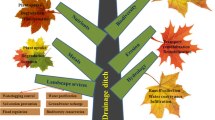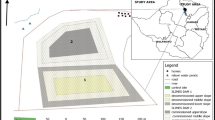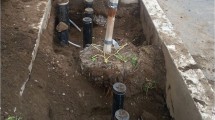Abstract
A sustainable means of preventing polluted particulates carried in urban storm water entering rivers, groundwater and lakes is by employing vegetated sustainable drainage system (SUDS) devices, or best management practices to trap or biodegrade them. In the UK, a mixture of grass species is recommended for use in devices such as swales or filter strips. However, there is little evidence in support of the efficiency of the individual grasses or mixtures to deal with such contaminated material. A pot-based pollutant retention study was conducted using processed street dust from central Coventry, UK, as a simulated pollutant to be applied in different quantities to a variety of recommended grasses for vegetated SUDS devices. Analysis was conducted on compost cores, roots and shoots for heavy metals (Cd, Cu, Ni, Pb and Zn). Street dust mainly concentrated in the top compost layer for all grasses with only the finer material migrating down the profile. Analysis of roots indicated little accumulation, with ANOVA statistical tests indicating significant differences in heavy metal concentrations, with less in the compost and more in the shoots. Development of root systems on or near the surface possibly explains increased uptake of heavy metals by some species. Overall Agrostis canina and Poa pratensis showed the greatest accumulations compared to their controls although Agrostis capillaris syn.tenuis and Agrostis stolonifera also demonstrated accumulation potential. On ranking, Agrostis canina and Poa pratensis were highest overall. These rankings will assist in selecting the best grasses to address pollution of the urban environment by contaminated particulates.




Similar content being viewed by others
References
Antoniadis, V., Robinson, J. S., & Alloway, B. J. (2008). Effects of short-term pH fluctuations on cadmium, nickel, lead, and zinc availability to ryegrass in a sewage sludge-amended field. Chemosphere, 71(4), 759–764.
Araújo, G. C. L., Gonzalez, M. H., Ferreira, A. G., Nogueira, A. R. A., & Nóbrega, J. A. (2002). Effects of acid concentration on closed–vessel microwave-assisted digestion of plant material. Spectrochimica Acta Part B, 57, 2121–2132.
Bablake Weather Station (Coventry) (n.d)—Available at: http://www.bablakeweather.co.uk/. Accessed December 3, 2015.
Barrett, M. E., Irish, L. B., Malina, J. F, Jr, & Charbeneau, R. J. (1998). Characterization of highway runoff in Austin, Texas area. Journal of Environmental Engineering, 124, 131–137.
Blanco-Canqui, H., Gantzer, C. J., Anderson, S. H., Alberts, E. E., & Thompson, A. L. (2004). Grass barrier and vegetation filter strip effectiveness in reducing runoff, sediment, nitrogen and phosphorus loss. Soil Science Society of America Journal, 68, 1670–1678.
BSI (British Standards Institution). (2015). Publicly Available Specification (PAS) for composted materials. (BSI PAS 100). London. http://tinyurl.com/jtcskh8. Accessed December 3, 2015.
Charlesworth, S. (2010). A review of the adaptation and mitigation of global climate change using sustainable drainage in cities. Journal of Water and Climate Change, 1(3), 165–180.
Charlesworth, S. M., Harker, E., & Rickard, S. (2003a). A review of sustainable drainage systems (SuDS): A soft option for hard drainage questions? Geography, 88(2), 99–107.
Charlesworth, S. M., Everett, M., McCarthy, R., Ordóñez, A., & De Miguel, E. (2003b). A comparative study of heavy metal concentration and distribution in deposited street dusts in a large and a small urban area: Birmingham and Coventry, West Midlands, UK. Environment International, 29(5), 563–573.
Charlesworth, S. M., & Warwick, F. (2012). Adapting and mitigating floods using sustainable urban drainage systems. In J. Lamond, C. Booth, F. Hammond, & D. Proverbs (Eds.), Flood Hazards: Impacts and responses for the built environment. Taylor and Francis: CRC Press.
Claytor, R. A., & Schueler, T. R. (1996). Design of stormwater filtering systems. Ellicott City: Center for Watershed Protection.
Clesceri, L. S., Greenberg, A. E., & Eaton, A. D. (1998). Standard methods for the examination of water and wastewater (20th ed., pp. 1–13). Maryland: United Book Press.
Defra (Department of Environment, Food and Rural Affairs) and EA (Environment Agency). (2002). Assessment of risks to human health from land contamination: An overview of the development of guideline values and related research. Report CLR7.
Deletic, A. (2005). Sediment transport in urban runoff over grassed areas. Journal of Hydrology, 301, 108–122.
Deletic, A., & Fletcher, T. D. (2006). Performance of grass filters used for storm water treatment—A field and modeling study. Journal of Hydrology, 317, 261–275.
DMRB (Design Manual for Roads and Bridges). (2006a). Volume 4, Section 2, Part 1, HA 103/06, Chapter 3: Vegetated drainage systems for highway runoff. Available at: http://tinyurl.com/os68jcx. Accessed December 3, 2015.
DMRB (Design Manual for Roads and Bridges). (2006b). Volume 4 Section 2 Drainage Part 9 HA 119/06, Chapter 10. Grassed surface water channels for highway runoff. Available at: http://tinyurl.com/ovbcaer. Accessed December 3, 2015.
EA (Environment Agency). (2009a). Soil guideline values for cadmium in soil. Science Report SC050021/Cadmium SGV. Available at: http://tinyurl.com/osnxe9v. Accessed December 3, 2015.
EA (Environment Agency). (2009b). Soil guideline values for nickel in soil. Science Report SC050021/Nickel SGV. Available at: http://tinyurl.com/okj3eop. Accessed December 3, 2015.
Escarameia, M., Todd A. J., & Watts, G. R. A. (2006). Pollutant removal ability of grassed surface water channels and swales: Literature review and identification of potential monitoring sites. Published Project Report PPR169. TRL Limited. Available at: http://tinyurl.com/ns5l26c. Accessed December 3, 2015.
Foster, I. D. L., Charlesworth, S. M., & Keen, D. H. (1991). A comparative study of heavy metal contamination and pollution in four reservoirs in the English Midlands, UK. Hydrobiologia, 214, 155–162.
Greater Dublin Strategic Drainage Study (nd) Available at: http://tinyurl.com/p3l7ahe. Accessed December 3, 2015.
Han, J., Wu, J. S., & Allan, C. (2005). Suspended sediment removal by vegetative filter strip treating highway runoff. Journal of Environment Science and Health, 40, 1637–1649.
ICRCL (Interdepartmental committee on the redevelopment of contaminated land) (1987). Guidance on the assessment and redevelopment of contaminated land, 2nd edn. DETR Publications.
Jurries, D. (2003). Biofilters (bioswales, vegetative buffers, and constructed wetlands) for storm water discharge pollution removal. State of Oregon, Department of Environmental Quality. Available at: http://tinyurl.com/prrv986. Accessed December 3, 2015.
Kalis, E. J. J., Temminghoff, E. J. M., Visser, A., & Van Riemsduk, W. H. (2007). Metal Uptake by Lolium Perenne L. in contaminated soils using a four-step approach. Environmental Toxicology and Chemistry, 26(2), 335–345.
Lucke, T., Mohamed, M. A. K., & Tindale, N. (2014). Pollutant removal and hydraulic reduction performance of field grassed swales during runoff simulation experiments. Water, 6, 1887–1904.
Roesner, L. A. (1999). Urban runoff pollution—Summary thoughts-the state-of-practice today and for the 21st century. Water Science and Technology, 39(12), 353–360.
Schueler, T. (2000). Comparative pollutant removal capability of stormwater treatment practices. In T. Schueler & H. Holland (Eds.), The practice of watershed protection. Ellicott City, MD: Center for Watershed Protection.
Taiz, L., & Zeiger, E. (2006). Plant physiology (4th ed.). Sunderland: Sinauer Associates Publishers.
USEPA (United States Environmental Protection Agency) (1999) Storm water technology fact sheet: Vegetated Swales. 832-F-99-006. Available at: http://tinyurl.com/njrhuol. Accessed December 3, 2015.
Walsh, P. M., Barrett, M. E., Malina, J. F., & Charbeneau, R. J. (1997). Use of vegetative controls for treatment of highway runoff. Center for Research in Water Resources, University of Texas, Austin, TX. Available at: http://tinyurl.com/o77dsg2. Accessed December 3, 2015.
Water U. K. (2008). Lessons learnt from Summer Floods 2007: Phase 2 report—Long-term Issues. Water UK’s Review Group on Flooding.
Wilson, S., Bray, R., & Copper, P. (2004). Sustainable drainage systems: Hydraulic, structural and water quality advice. London: CIRIA.
Wilson, S., Newman, A. P., Puehmeier, T., & Shuttleworth, A. (2003). Performance of an oil interceptor incorporated into a pervious pavement. Engineering Sustainability, 156, 51–58.
Winer, R. (2000). National pollutant removal database for stormwater treatment practices (2nd ed.). Ellicott City: Center for Watershed Protection.
Woods Ballard, B., Kellagher, R., Martin, P., Jefferies, C., Bray, R., & Shaffer, P. (2007). The SUDS manual (C697). London: Construction Industry Research and Information Association.
Acknowledgments
Dr David Lawson of the Sports Turf Research Institute, Bingley, UK, provided the grass seeds for the trials and also recommendations for planting density for which we are grateful.
Author information
Authors and Affiliations
Corresponding author
Rights and permissions
About this article
Cite this article
Charlesworth, S.M., Bennett, J. & Waite, A. An evaluation of the use of individual grass species in retaining polluted soil and dust particulates in vegetated sustainable drainage devices. Environ Geochem Health 38, 973–985 (2016). https://doi.org/10.1007/s10653-016-9791-7
Received:
Accepted:
Published:
Issue Date:
DOI: https://doi.org/10.1007/s10653-016-9791-7




